
 |
|
#1
|
|||
|
|||
|
Hello all. OK I've been wanting to do Chladni patterns for awhile now, trusting Alan Carruth's belief that tap tuning spectra may not be as helpful as chladni patterns in determining how "good" or at least responsive a guitar is. Gore and Gilets book unified the thinking around the relationship between tap tuning and chladni patterns for me and thus the following data!
I looked at the chladni patterns on my own build, an Adi-walnut L-00 and my SCGC all mahogany 000. I used audacity for tap tones and iOS app sig gen to move the black tea leaves. The main tap tones for the L00: main air - 104 hz Main top - 176 hz back - 220 hz and upper bout secondary peaks at 262 and 327 hz. Chladni pattern frequencies that moved the tea leaves: 98 hz 183 hz 354 hz SCGC: main air - 108 hz main top - 184 hz back - 222 hz and secondary at 336 hz. Chladni pattern frequencies that moved the tea leaves: 110 hz 195 hz 345 hz Here's what I got. Seems like the L00 doesnt resonate much in the lowest lower bout but beats out the SCGC in getting more the top near the side edges resonating.........I dont understand the pile up at the bridge on the L00. I would love to get all the feedback I can on these patterns. Thanks for looking. Sam 98 hz 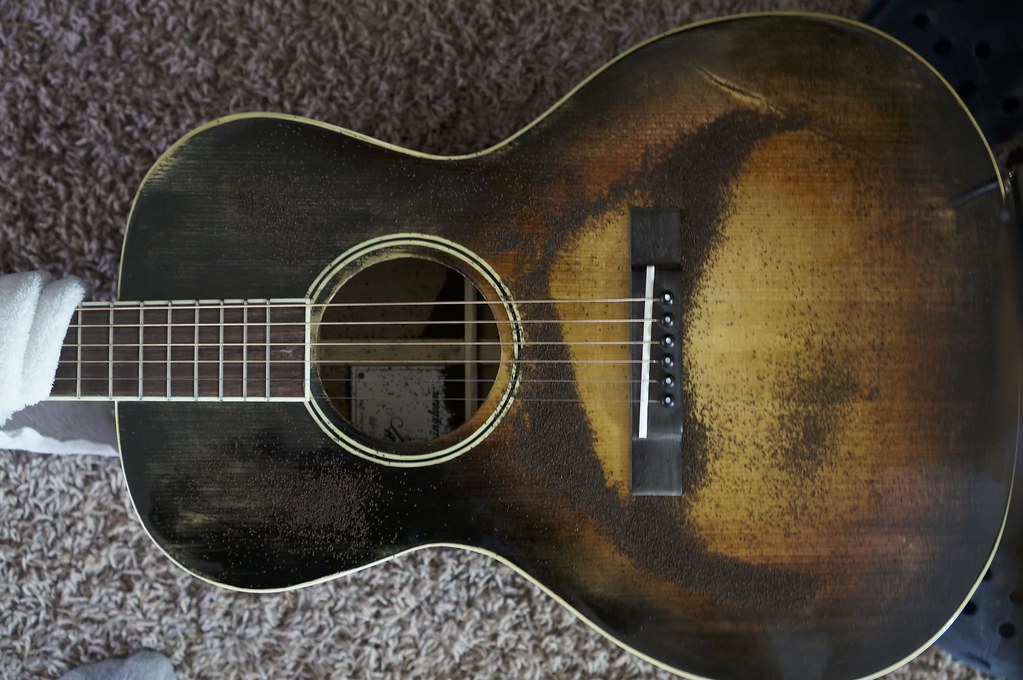 DSC04092 by Sam Van, on Flickr DSC04092 by Sam Van, on Flickr183 hz 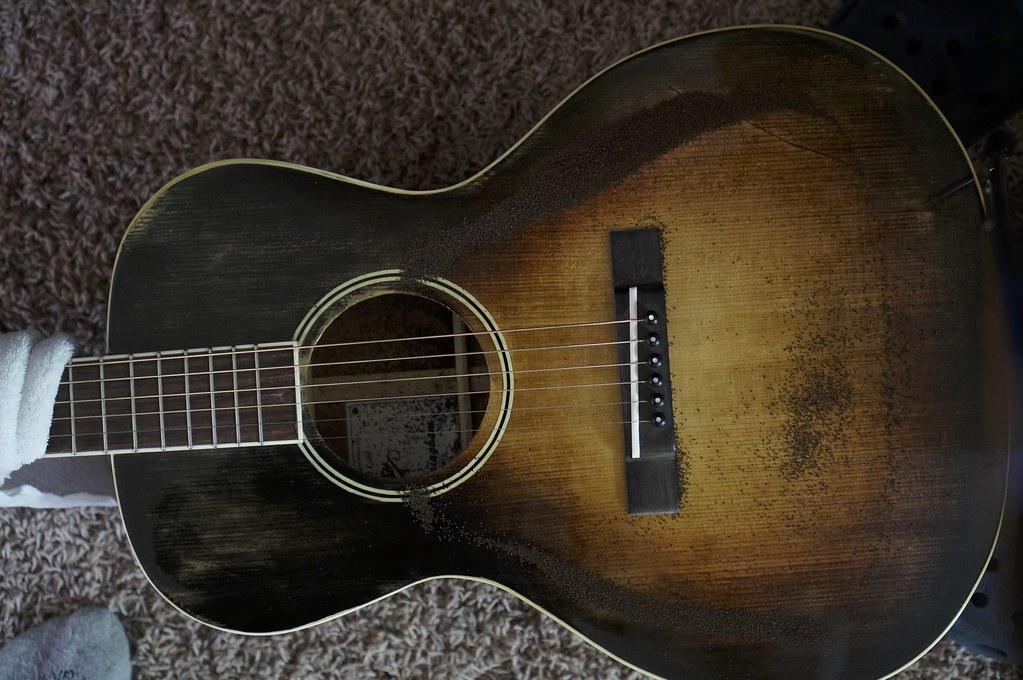 DSC04090 by Sam Van, on Flickr DSC04090 by Sam Van, on Flickr354 hz 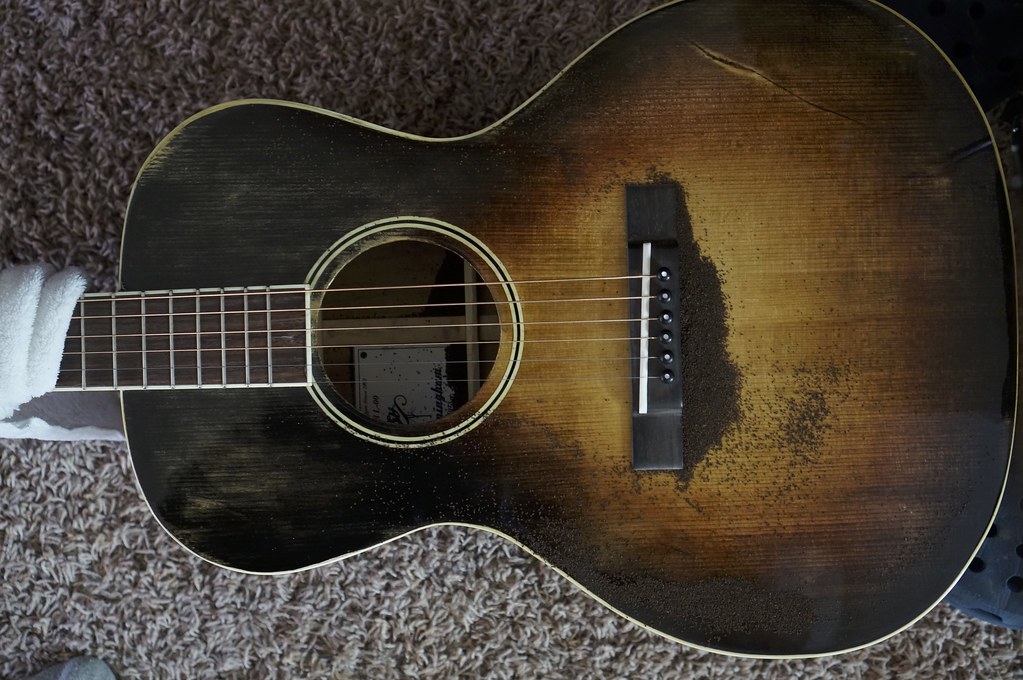 DSC04091 by Sam Van, on Flickr DSC04091 by Sam Van, on FlickrSCGC 110 hz 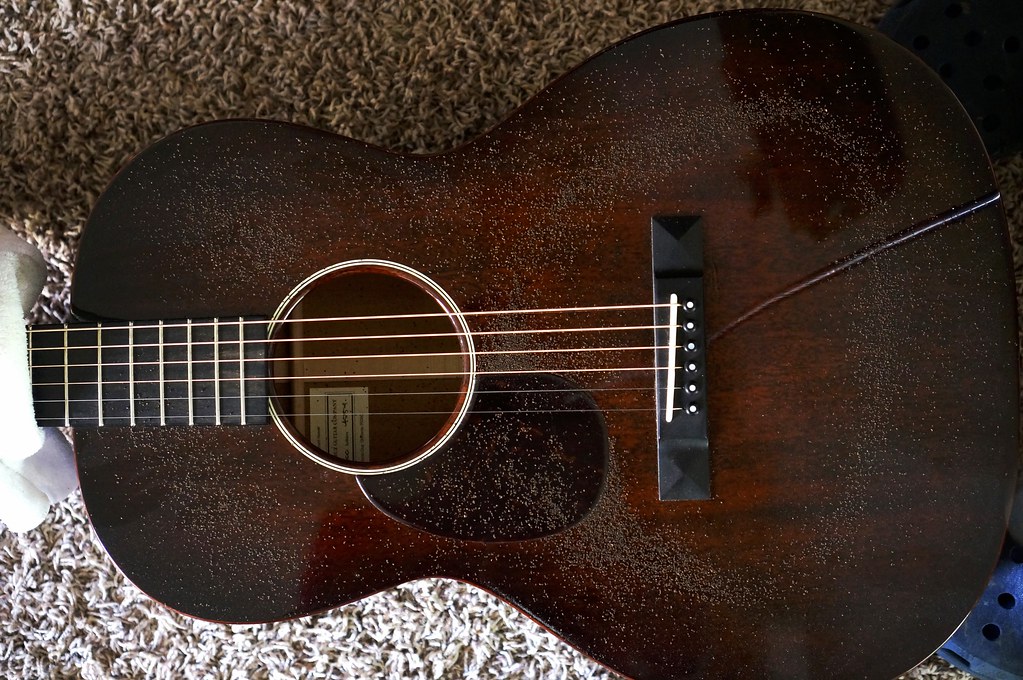 DSC04097 by Sam Van, on Flickr DSC04097 by Sam Van, on Flickr195 hz  DSC04098 by Sam Van, on Flickr DSC04098 by Sam Van, on Flickr345 hz  DSC04099 by Sam Van, on Flickr DSC04099 by Sam Van, on Flickr
|
|
#2
|
|||
|
|||
|
Hello Sam! I'm also interested on the information regarding this!
Here, in the website posted bellow, I found the target frequencies for the top/back. According to the author,these values were taken from Gore/Gilet book! I still don't understand how this whole "rocket science" works but I hope this topic and the more experienced can help us! (props to Alan Carrut). Here's the link http://tommillerguitars.com/voicing/ Edit: Sam, I also found this very interesting piece of information. In this blog, Alan Lloyd has a table on how to inacrease/decrease monopole/dipole frequencies (although I still don't understand them, T,T) https://alanlloydguitars.wordpress.c...tar-acoustics/
__________________
Hikari. Last edited by HikariGuitars; 10-13-2015 at 12:41 PM. |
|
#3
|
|||
|
|||
|
The problem is that Chladni patterns on the assembled guitar don't tell you as much as you'd like. You have to mess up the structure pretty badly to not get the 'ring' on the top, and even the cross and long dipoles are pretty robust, in the sense tat you can almost always get them at some frequency.
Where I use Chladni patterns to advantage, IMO, is on the 'free' plates: the top and back before they're glued to the rim. This is controversial. The 'free' plate patterns and frequencies don't predict the lower order assembled modes in any simple way, and it is certainly the case that it's the assembled modes that count. However, I've got enough evidence linking 'free' plate mode shapes to perceived quality that I use them in my build process. It would be very difficult to 'prove' efficacy here. It would help a lot of we could get to the point where we can make 'identical' guitars that actually sound the same, and perhaps eventually that will happen. The assembled patterns do, of course, tell you what part of the guitar is producing which peak in the spectrum, and that's helpful. The pitches of those peaks have some bearing on the timbre of the guitar, of course. The mode shapes can give you some information on the effective area of the modes, although that might be trickier that it seems. You can use them to track the effects of changes such as adding mass or shaving braces. |
|
#4
|
|||
|
|||
|
Quote:
Quote:
Anyways, I look forward to seeing patterns on the free plates coming soon. I hope you get to see them and help me out  . . Sam And here are some patterns on my newest build, Lutz-Pernambuco. Looks to me that this one is resonating better than either mine or the SCGC, yes, no? 100 Hz 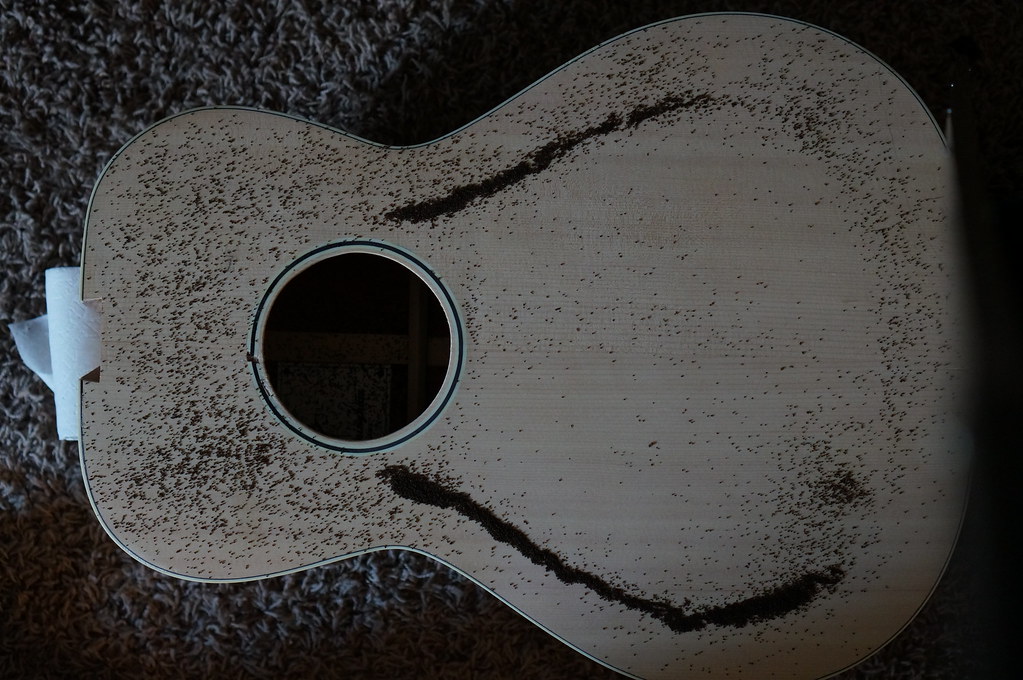 Untitled by Sam Van, on Flickr Untitled by Sam Van, on Flickr186 hz 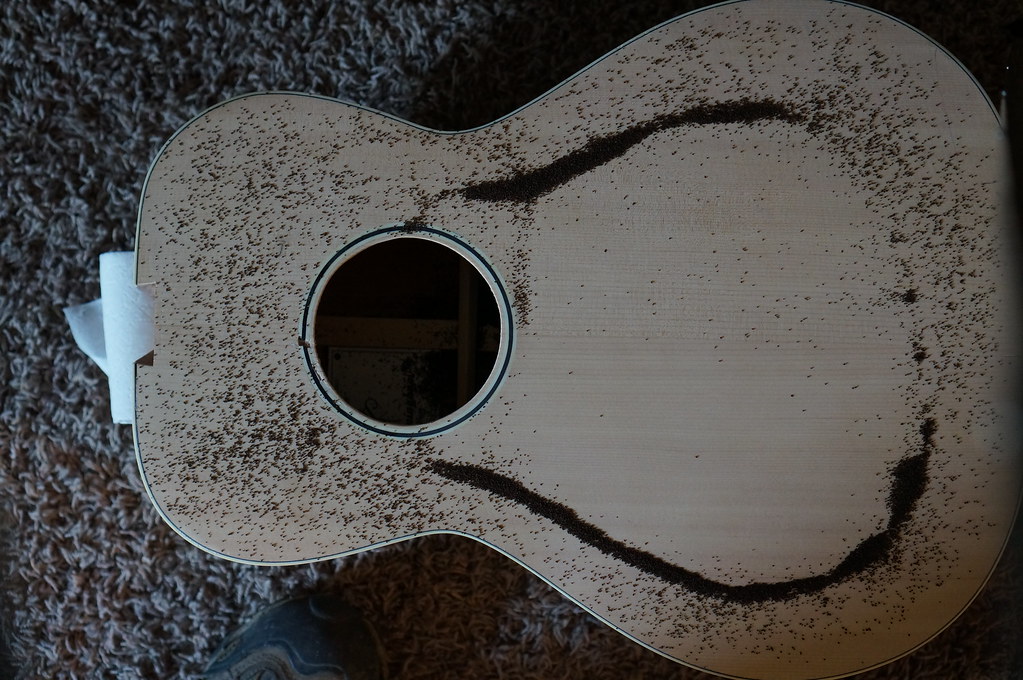 Untitled by Sam Van, on Flickr Untitled by Sam Van, on Flickr213 hz  Untitled by Sam Van, on Flickr Untitled by Sam Van, on Flickr330 hz 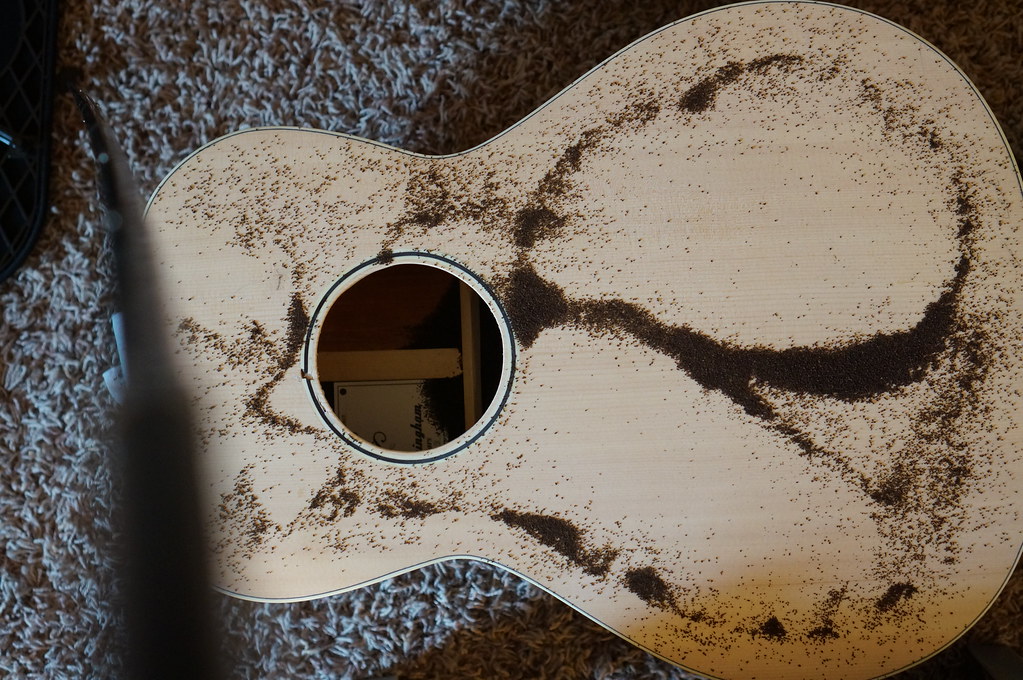 Untitled by Sam Van, on Flickr Untitled by Sam Van, on Flickr440 hz  Untitled by Sam Van, on Flickr Untitled by Sam Van, on Flickr
|
|
#5
|
|||
|
|||
|
Left of Sam asked:
"So you really don't think that how far out towards the edges the patterns reach is indicative of how much of the top is contributing to the volume/tone?" That's not what I said. What I'm saying is that you WILL see a closed ring on any guitar top that isn't totally messed up, and that it's presence is no predictor of the sound. Gore goes into the physics behind his practice of adding mass to the sides to move the nodes out, and it's right on. He's talking about location of the node relative to the perimeter of the top, which has far more to do with the mass of the sides than it does with the top. |
|
#6
|
|||
|
|||
|
Quote:
But the point about gores heavier sides discovery clarifies for me that if indeed we saw ring+ patterns further out towards the edges on assembled bodies, it's likely more a fcn of side thickness. Ok thanks for your thoughts. Sam |
|
#7
|
|||
|
|||
|
How do you "tap" the air...??
"The main tap tones for the L00: main air - 104 hz"
__________________
---- Ned Milburn NSDCC Master Artisan Dartmouth, Nova Scotia |
|
#8
|
|||
|
|||
|
Ned Milburn asked:
"How do you "tap" the air...??" Well, let's see... When you tap the top it moves in and out, and drives air in an out of the sound hole. That's actually part of a 'bass reflex couple' between the top and the Helmholtz air resonance, and the pitch you hear tends to be the 'air' pitch. Being lower in frequency than the associated 'wood' pitch of the top, and also quite strong, the air mode sound masks the top tap tone. You can hear the top and back tones by themselves (more or less) by blocking the hole with your hand as you hold the guitar up by pinching the upper transverse brace and fingerboard end between your fingers and thumb. Try to not touch the top (just try!  ) ) Most of the 'higher order' air modes are harder to hear, in part because many of them don't 'talk' with the sound hole. They can affect the way the top vibrates, though, and thus alter the sound even if you can't hear them directly. My violin making teacher did experiments where she filled the body of a fiddle with CO2 or Freon to alter the air mode pitches, and measured the changes in the sound. Since those gasses are heavier than air they'd more or less stay put while you played a violin, since the holes point up, so it was possible to play the instruments and hear the results, as well as making measurements. They wanted to try helium, but nobody could play the fiddle standing on their head... It would be fun to try those experiments with a guitar some time. Sound ports can 'listen' to internal air modes that the regular hole misses. Ports up at the base of the neck, for example, put out a lot of sound from the 'A-1' air resonance. This is a mode where the air can be seen as 'sloshing' along the length of the box, usually at around 350 Hz. Opening a port that can tap into that shifts the pitch up a bit, and you can see a prominent peak in that range on any guitar that has ports in that location. The same should hold for those guitars with the sound hole up in the corner of the upper bout. Again, if you tap on the top, it can drive that mode, and vice versa. At any rate, we know much less about the air resonances of the guitar than we do about the wood, and that's little enough. |
|
#9
|
||||
|
||||
|
Totally off topic, I really dig your L-00!
|
|
#10
|
||||
|
||||
|
I recommend that you invest $15 to buy this Chladni presentation from Mark.
http://www.blanchardguitars.com/guit...hladni_buy.php
__________________
A bunch of nice archtops, flattops, a gypsy & nylon strings… |
|
#11
|
|||
|
|||
|
Quote:
Sam |
|
#12
|
|||
|
|||
|
Thanks Matt! Looking forward to bursting the new one I'm building. Sam |
|
#13
|
|||
|
|||
|
Quote:
BTW, sometimes I listen to a lot of guitars on Dreamguitars website. However, I dont listen to too many classicals. But one caught my eye and ears. I take it you built this guitar? Wow. Nice. Very nice.... Sam |
|
#14
|
||||
|
||||
|
Mark takes you through how he applies the technique to his building process in a very practical and digestable way. He learned from Alan C. at course he gave 19-years ago. This was a talk that he gave at the Healdsburg Guitar festival about 8-years ago. He uses the technique to tune free plates unbraced and braced (top and back). He also speaks a bit about the limitations of what you are attempting to do on assembled bodies. It is a bargain for $15...
__________________
A bunch of nice archtops, flattops, a gypsy & nylon strings… |
|
#15
|
|||
|
|||
|
Quote:
__________________
---- Ned Milburn NSDCC Master Artisan Dartmouth, Nova Scotia |